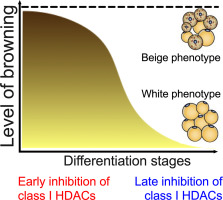当前位置:
X-MOL 学术
›
BBA Mol. Cell Biol. Lipids
›
论文详情
Our official English website, www.x-mol.net, welcomes your feedback! (Note: you will need to create a separate account there.)
Inhibition of class I HDACs imprints adipogenesis toward oxidative and brown-like phenotype.
Biochimica et Biophysica Acta (BBA) - Molecular and Cell Biology of Lipids ( IF 4.8 ) Pub Date : 2020-01-02 , DOI: 10.1016/j.bbalip.2019.158594 Alessandra Ferrari 1 , Raffaella Longo 1 , Carolina Peri 1 , Lara Coppi 1 , Donatella Caruso 1 , Antonello Mai 2 , Nico Mitro 1 , Emma De Fabiani 1 , Maurizio Crestani 1
Biochimica et Biophysica Acta (BBA) - Molecular and Cell Biology of Lipids ( IF 4.8 ) Pub Date : 2020-01-02 , DOI: 10.1016/j.bbalip.2019.158594 Alessandra Ferrari 1 , Raffaella Longo 1 , Carolina Peri 1 , Lara Coppi 1 , Donatella Caruso 1 , Antonello Mai 2 , Nico Mitro 1 , Emma De Fabiani 1 , Maurizio Crestani 1
Affiliation

|
Obesity is characterized by uncontrolled expansion of adipose tissue mass, resulting in adipocyte hypertrophy (increased adipocyte size) and hyperplasia (increased number of adipocytes). The number of adipose cells is directly related to adipocyte differentiation process from stromal vascular cells to mature adipocytes. It is known that epigenetic factors influence adipose differentiation program. However, how specific epigenome modifiers affect white adipocyte differentiation and metabolic phenotype is still matter of research. Here, we provide evidence that class I histone deacetylases (HDACs) are involved both in the differentiation of adipocytes and in determining the metabolic features of these cells. We demonstrate that inhibition of class I HDACs from the very first stage of differentiation amplifies the differentiation process and imprints cells toward a highly oxidative phenotype. These effects are related to the capacity of the inhibitor to modulate H3K27 acetylation on enhancer regions regulating Pparg and Ucp1 genes. These epigenomic modifications result in improved white adipocyte functionality and metabolism and induce browning. Collectively, our results show that modulation of class I HDAC activity regulates the metabolic phenotype of white adipocytes via epigenetic imprinting on a key histone mark.
中文翻译:

I类HDAC的抑制作用使脂肪生成趋向于氧化和类似棕色的表型。
肥胖症的特征是脂肪组织质量不受控制地膨胀,导致脂肪细胞肥大(脂肪细胞大小增加)和增生(脂肪细胞数量增加)。脂肪细胞的数量与从间质血管细胞到成熟脂肪细胞的脂肪细胞分化过程直接相关。已知表观遗传因素影响脂肪分化程序。然而,特定表观基因组修饰物如何影响白色脂肪细胞分化和代谢表型仍是研究的问题。在这里,我们提供的证据表明,I类组蛋白脱乙酰基酶(HDAC)参与脂肪细胞的分化和确定这些细胞的代谢特征。我们证明,从分化的第一阶段抑制I类HDAC会放大分化过程,并使细胞向高度氧化的表型烙印。这些作用与抑制剂调节调节Pparg和Ucp1基因的增强子区域上H3K27乙酰化的能力有关。这些表观基因组修饰可改善白色脂肪细胞的功能和代谢,并引起褐变。总体而言,我们的结果表明,通过关键组蛋白标记的表观遗传印迹,对I类HDAC活性的调节可调节白色脂肪细胞的代谢表型。这些表观基因组修饰可改善白色脂肪细胞的功能和代谢,并引起褐变。总体而言,我们的结果表明,通过关键组蛋白标记的表观遗传印迹,对I类HDAC活性的调节可调节白色脂肪细胞的代谢表型。这些表观基因组修饰可改善白色脂肪细胞的功能和代谢,并引起褐变。总体而言,我们的结果表明,通过关键组蛋白标记的表观遗传印迹,对I类HDAC活性的调节可调节白色脂肪细胞的代谢表型。
更新日期:2020-01-02
中文翻译:

I类HDAC的抑制作用使脂肪生成趋向于氧化和类似棕色的表型。
肥胖症的特征是脂肪组织质量不受控制地膨胀,导致脂肪细胞肥大(脂肪细胞大小增加)和增生(脂肪细胞数量增加)。脂肪细胞的数量与从间质血管细胞到成熟脂肪细胞的脂肪细胞分化过程直接相关。已知表观遗传因素影响脂肪分化程序。然而,特定表观基因组修饰物如何影响白色脂肪细胞分化和代谢表型仍是研究的问题。在这里,我们提供的证据表明,I类组蛋白脱乙酰基酶(HDAC)参与脂肪细胞的分化和确定这些细胞的代谢特征。我们证明,从分化的第一阶段抑制I类HDAC会放大分化过程,并使细胞向高度氧化的表型烙印。这些作用与抑制剂调节调节Pparg和Ucp1基因的增强子区域上H3K27乙酰化的能力有关。这些表观基因组修饰可改善白色脂肪细胞的功能和代谢,并引起褐变。总体而言,我们的结果表明,通过关键组蛋白标记的表观遗传印迹,对I类HDAC活性的调节可调节白色脂肪细胞的代谢表型。这些表观基因组修饰可改善白色脂肪细胞的功能和代谢,并引起褐变。总体而言,我们的结果表明,通过关键组蛋白标记的表观遗传印迹,对I类HDAC活性的调节可调节白色脂肪细胞的代谢表型。这些表观基因组修饰可改善白色脂肪细胞的功能和代谢,并引起褐变。总体而言,我们的结果表明,通过关键组蛋白标记的表观遗传印迹,对I类HDAC活性的调节可调节白色脂肪细胞的代谢表型。



























 京公网安备 11010802027423号
京公网安备 11010802027423号